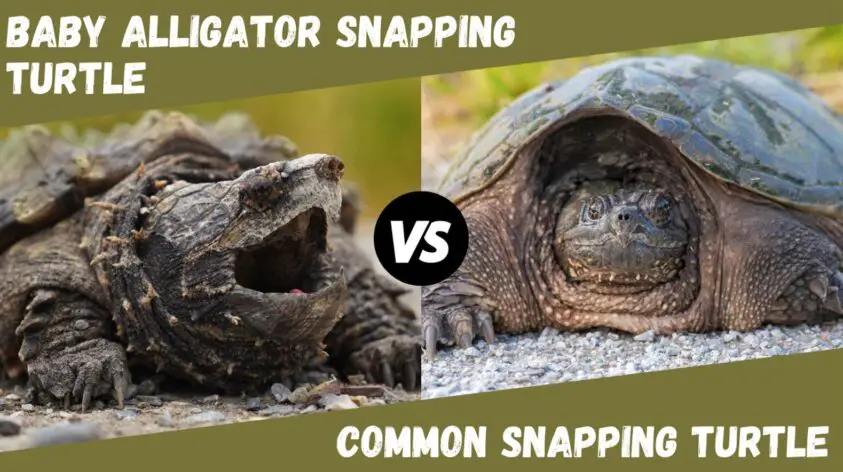While both the baby alligator snapping turtle and the common snapping turtle are both a part of the gene family chelydrdae they do have some differences.
In today’s article, we are going to discuss the commonalities and differences between the baby alligator snapping turtle and the common snapping turtle.
Baby Alligator Snapping Turtle vs Common Snapping Turtle
The main differences between a baby snapping turtle and a common snapping turtle is their physical appearance, size, and lifespan.
Physical Description
Alligator Snapping Turtle

Common Snapping Turtle

The two assortments of snapping turtle both look like ancient reptiles. They both have pointed tails, a spiked looking shell, and an enormous mouth. If you have questions about their tails, you should check out my article on why do turtles have tails.
A baby snapping turtle is usually only 3-4 inches long when born, whereas a common snapping turtle baby is typically 2-4 inches when it hatches.
The alligator snapping turtle reaches a much larger size, as it can weight up to 180 lbs when it reaches adulthood. Conversely, the common snapping turtle usually reaches a weight of 25-30 lbs lbs.
A baby alligator snapping turtle typically has its eyes on the side of its head, whereas the common snapping turtle has eyes on the top of their head near their beak.
Additionally, baby alligator snapping turtles typically have a darker complexion compared to common snapping turtles. It is common for moss to grow on these turtle’s shells.
Natural Habitat
The alligator snapping turtle lives primarily in the southeastern United States. They range from Florida to southern Georgia, west into Texas and north into parts of Illinois. The common snapping turtle has a more northwestern reach from Alberta, Canada, to Nova Scotia, but is also found in the southeastern part of the united states.
Both species of alligators live exclusively in freshwater territories like rivers, lakes, ponds, and brackish water. The common snapping turtle can endure more bitter conditions, for example, salt bogs or marshes close to seaside regions.
Diet and Predators
Snapping turtles are forceful trackers, utilizing incredible jaws to snap and rapidly kill prey. The common snapping turtle is omnivorous which means it east both plants and animals. Some animals include animals include fish, birds, and frogs.
The alligator snapping turtle is more carnivorous, as it uses its large size to track down bigger prey. They primarily eat aquatic animals, but some have been known to eat small mammals.
While snapping turtles typically don’t have any predators, their eggs and hatchling are susceptible to fish, birds and snakes.
Life Cycle
Both the common snapping turtle and baby snapping turtle lay their eggs in the late-spring, early summer months. This is typically between May and June, but it does range between locations. Both species of turtles lay between 20 and 40 eggs per clutch.
Common snapping turtle eggs take nine to 18 weeks to incubate, while alligator snapping turtle eggs usually take 14 to 20 weeks. Neither one of the species gives care for their eggs after they hatch. The alligator snapping turtle usually lives for 80-120 years in the wild, while the common snapping turtle usually reaches an age of 40-60 years.

